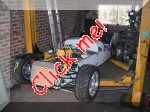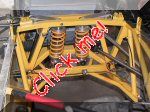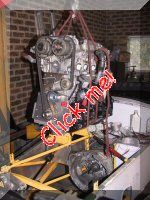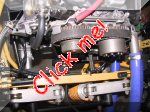
|
On the left is the car on the
hoist, sans engine.
Most of the work was
being done to set up fitting the engine, electrics, and plumbing.
On the right is the
front suspension, which an inboard rocker type. The car has
double-adjustable Koni's all round. We also added a couple of small
strips of steel on the lower suspension arms, both to put them into
double sheer (for improved rigidity) and also to hang the brakes hoses
off. The left-hand solid brake line ended up a bit ugly, and
needs to be fixed up eventually. We also added a couple of small alloy
tabs to the lower bolts on the spring assembly to also help hold the
brake line in place.
|

|

|
The engine was very hard to get
in!!
It's uncomfortably
longer than the distance between the front of the bell housing and the
upper edge of the engine bay. (The yellow tube in the pic, behind the
suspension rockers) By lifting the gearbox and allowing the cam belt to
flex around we got the engine in, but for sure next time we'll fit the
cam belt after the engine
sits in place.
On the right you can
see the three belts that hang off the front of the engine. The cam belt
of course, then the alternator belt, then the dry sump pump belt out in
front. Getting an alternator belt the right length proved difficult to
find as initially we couldn't find one less than 690mm long- We needed
about 660mm - That meant it was too long and the alternator would hit
the side of the engine bay, so a larger pulley was found. To make that
one work, a belt 735mm long was fitted. Then when the engine was in
place the larger pulley then hit the side of the engine bay. After some
more head scratching I accidentally came across a belt 640mm long (not
supposed to exist in most books) and it just fits in okay, with the
smaller pulley.
To get tension on the
dry sump pump a belt almost exactly the right length had to be found,
then the last little bit of tension taken up with washers under the
pump to space it out just right.
Back to the left picture. We also couldn't find the right length belt
for the cams, so we ended up getting one that was not quite as wide as
what we would have liked. When we were winding the engine over to get
oil pressure, the belt started to come apart! So we did some more
searching and found yet another belt that is wider but a little longer,
thus there is now yet another idler/tensioner pulley on the other side
of the engine. (About where the bit of wire is pointing to)
Something that
would normally take minutes in a regular road car took days and days on
this one ....
|

|

